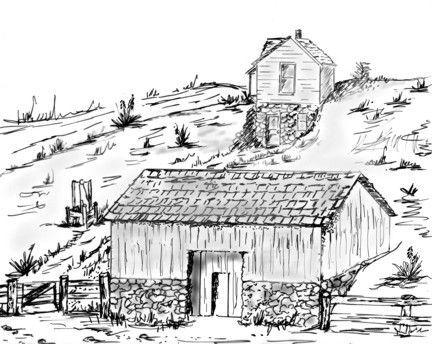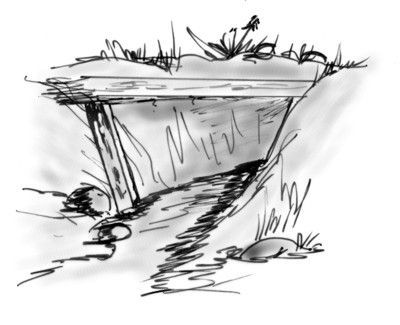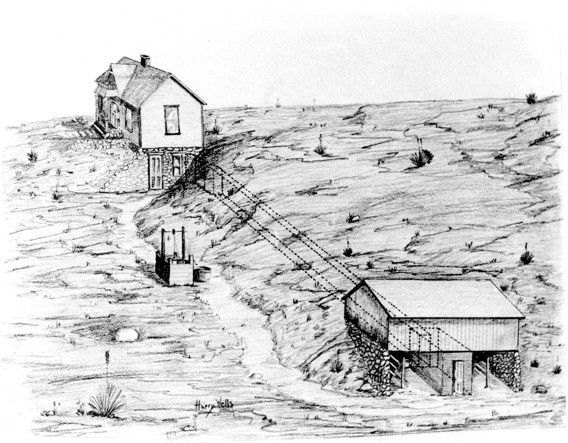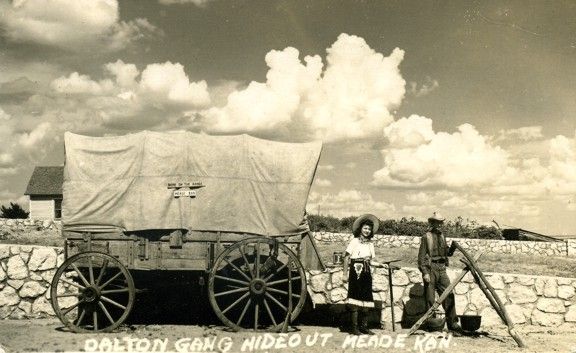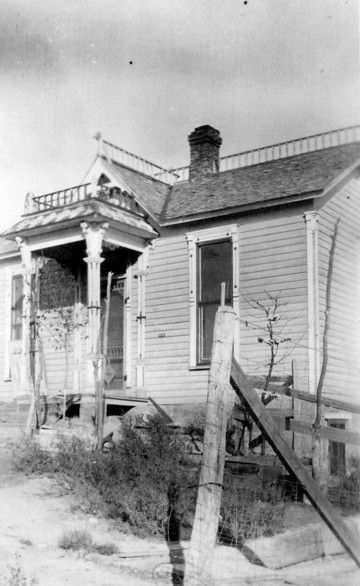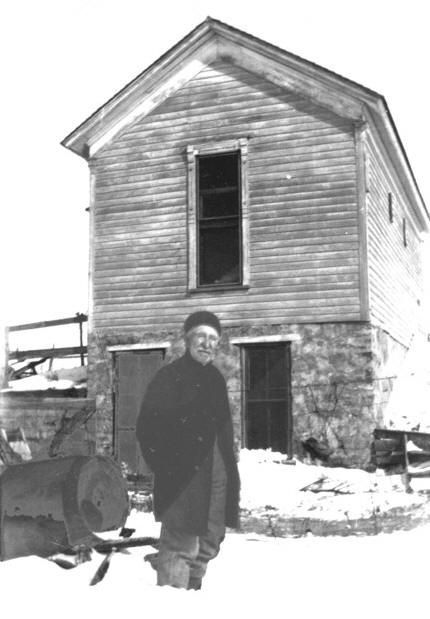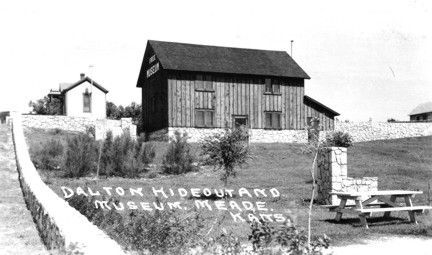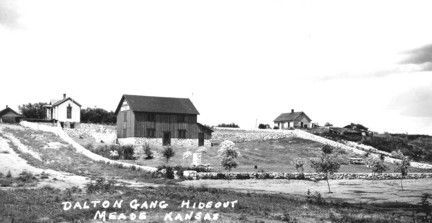History of the Dalton Gang Hideout
With permission from "The Dalton Gang and Their Family Ties" by Nancy Ohnick (copyright)
The Preservation of an Outlaw Hideout
In the southern part of Meade, Kansas, four blocks south of highway 54, still stands the two-room house that was first occupied by Mr. and Mrs. J.N. Whipple. Eva Dalton, sister of the infamous outlaws, married J.N. Whipple October 15, 1887, at which time they moved into the newly constructed house Whipple had built for his bride. The house was on the outskirts of town in those days, the landscape dropped sharply from the house to a streambed to the south where water occasionally flowed into Crooked Creek to the east. A sharp bluff to the south of the streambed formed a canyon of sorts, later dubbed, "Gallop Away Canyon." Taking advantage of the landscape, Whipple built his house half underground with one exposed wall and a door leading from the basement to the south. Their barn also was half sheltered by the earth in the hill below.
Eva Dalton came to Meade shortly after the town was established in 1885. She was engaged in a millinery business with Florence Dorland, who later married R.A. Harper, an early-day Meade County rancher. Whipple operated a mercantile store in on the northwest corner of the square. Fairly successful as a businessman, he was reported to have been a good poker player, often holding games at the Whipple home.
The Dalton brothers were reportedly seen several times in Meade before a price was set on their heads, but their sister was never heard to mention their names after they became famous.
The Whipples left Meade by early 1892, and their property was sold under foreclosure. Soon after, the H.G. Marshall family moved into he house. The new occupants discovered a tunnel from the house to the barn. Inside the house the mouth of the tunnel was hidden by a small closet beneath the stairway leading to the two-room basement of the place. The tunnel was constructed by placing beams of wood across a deep rain wash which were then covered with earth. It was barely large enough for a man to walk through in a stooped position. From the house the tunnel led into a small feed room in the barn, which hid the tunnel entrance.
One of the Marshall daughters, Mrs. Roy Talbott, often told the story that several times horseback riders came up the canyon to the barn; placed their hoses in the barn and came on into the house through the tunnel. When the surprised riders learned that another family occupied the house, other than the Whipples, they immediately fled back through the tunnel, mounted their horses and galloped away.
Legend has it that many of the old-timers of Meade were very friendly with the Dalton Gang and thus the gang never raided the Meade banks or committed any overt acts in this vicinity. Old timers were always tight lipped about the notorious brothers.
In 1934, the Wayne Settle family was living in the house. At that time an old man came through Meade from Ohio on his way to California. He drove down to the house and visited a half hour with the Settle family. He told them of the days when he was with the gang and of the tunnel. The Settle family did not know of its existence. The entrance under the stairway had been rocked up and the basement given a coat of plaster over the natural rock walls. However, the old fellow showed them where the rocked-up entrance was and examination showed that the rocked-up entrance was recessed four inches deeper than the wall.
When the Dalton Gang Hideout was developed as a tourist attraction in 1940, Frank Fuhr, former editor of the Mede Globe Press, recalled that many times he had watched riders come up the canyon and into the barn. He stated that he never saw the riders come out of the barn and go to into the house and he suspected there was a tunnel. Later he learned of its existence, but he did not dare mention it back in the eighties. Fuhr lived across the canyon south and west of the Whipple property and became so intrigued with the activity at the Whipple home he purchased a spyglass to watch the comings and goings of the gang.
In 1940, many older residents remembered the secret tunnel and the youngsters of the nineties remembered playing in it. This editor interviewed Mrs. Byron Fisher who lived across the street from the property during her childhood. She said she and her brother played with the children who lived in the Whipple house. She remembers playing in what was left of the tunnel from the barn entrance, she doesn't remember too much about it, but can remember that they called it the "tunnel."
This editor received a letter in 1988, from Mr. Clyde W. Blackburn, respected treasure hunter and historian from Leoti, Kansas. We had discussed finding proof of the tunnel at an earlier date. Mr. Blackburn wrote:
"I really don't think I can add too much as that was over fifty years ago and I wasn't at all that interested in history at that time. I was surprised at your remark that there was no proof the tunnel was actually used by the Daltons. Certainly that much work wasn't done for the fun of it. If my father were still around I am sure he could have added some proof as he was a true history buff and spent a lot of time in the Meade and Clark County area over the years. He was a good friend of Lon Ford, the colorful sheriff of Clark County, and was with him on several excursions. I have tired to call on my memory as to what he told me about the house, tunnel, and barn but it is so hazy I can't seem to put it together. I do know he was well acquainted with the lady who lived in the house at the time and had apparently been there
many years before. This is no doubt the reason I was given free run of the tunnel and all the relics, which were stacked and hanging in the barn. It was a rather eerie trip as I walked down the tunnel with the dirt walls, which as I remember, were supported somewhat haphazardly with occasional boards. For the life of me, I can't remember where I got the information, but somewhere I gained the fact that on three different occasions the Daltons visited Meade and that on at least one of them did use the tunnel to make their escape."
An Invitation to the World
The Dalton Gang Hideout as a tourist attraction found its beginnings in 1940. Walter and Ruth Dingess were operating a cafe in Englewood, Kansas, and looking for a place to open a museum to house their growing collection of artifacts. Walter was, in fact, checking with the Big Well in Greensburg the day Joe Ross and J.W. Cooper went to his cafe to approach him with the idea of coming to Meade. The two left word for the Dingess to come to a Chamber of Commerce meeting and present their ideas, which they did--the rest is history.\
Mr. Ross wasn't even aware at the time of the historical significance of the little house at the corner of Pearlette and Green Street; his father brought it to his attention and it turned out to be the perfect solution for the City of Meade and Walter and Ruth Dingess.
The house was acquired by the Chamber of Commerce by means of a trade for another house, and in May, 1940, the Dingess family moved in. The above sketch by Harry Wells illustrates the plans they had to rebuild the tunnel and barn.
Walter, Ruth and their teenage daughter lived in the little Whipple house for five years. They lived upstairs while selling their souvenirs in the basement.
Much of the landscaping and improvements to the Dalton Hideout were accomplished by use of WPA labor. These crews built the rock retaining walls and NYA crews reconstructed the tunnel and the barn. Rock for the projects was quarried from the Clark Ranch east of Meade. The park was completed two years later in March, 1942.
In 1951, Mr. Dingess built Dad's Country Store, the 10'x12' building with a roofed porch just south of the wishing well. In 1988, the Chamber of Commerce added a building to house handicap-accessible restrooms to the east of the Whipple house.Except for the cottonwood trees that have grown to gigantic proportions in the little park south of the barn, and these recent additions, the Hideout looks much the same as it did in its beginning in 1942.
Walter Dingess retired in 1956 and turned the gift shop and souvenir business over to Ruth. She operated the Hideout until 1970. The Chamber of Commerce operated the Hideout until the property was deeded over to the Meade County Historical Society in 1995, in whose care it remains today.
